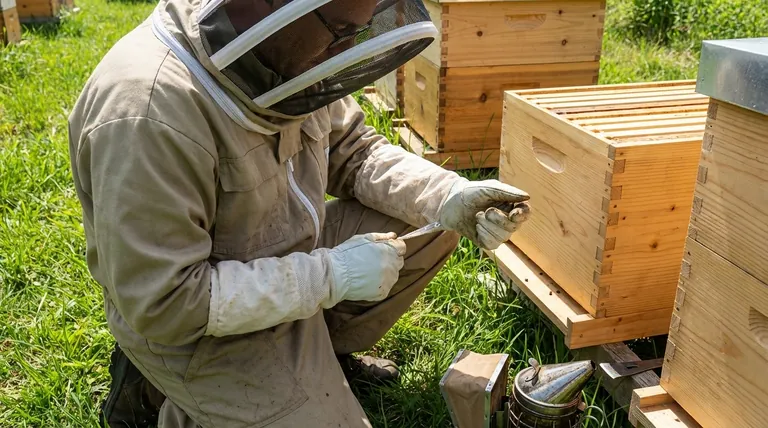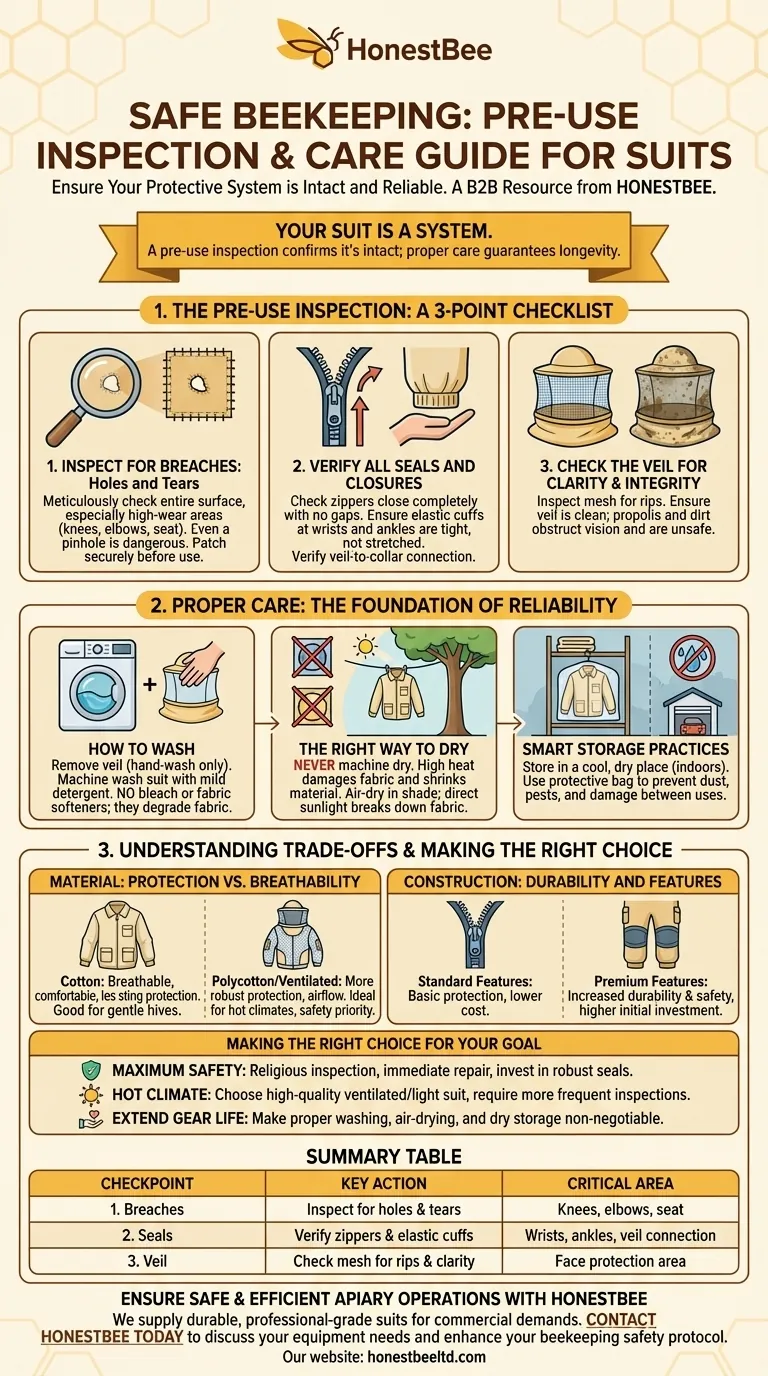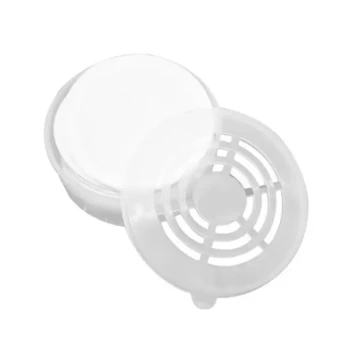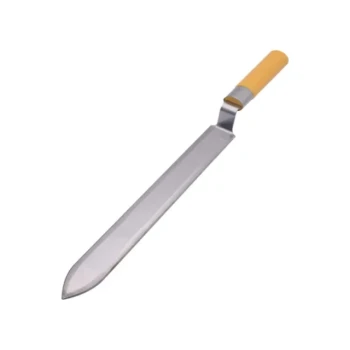Before approaching your hives, the single most critical action is to perform a thorough visual and physical inspection of your entire beekeeping suit. You are looking for any holes, tears, or failing seams that could serve as an entry point for a bee. Repairing even the smallest breach is non-negotiable, as this inspection is your final checkpoint to ensure the suit remains a sealed, protective barrier.
Your beekeeping suit is not just a piece of clothing; it is a system designed to keep you safe. A pre-use inspection confirms the system is intact, while proper long-term care is what guarantees its reliability and longevity.

The Pre-Use Inspection: A 3-Point Checklist
Before every single trip to the apiary, perform this quick but vital check. It should become an ingrained habit.
1. Inspect for Breaches: Holes and Tears
The most obvious and dangerous failure point is a hole in the fabric. Meticulously check the entire surface of the suit, paying special attention to high-wear areas like the knees, elbows, and seat.
Even a pinhole is large enough for a determined bee to exploit. Any damage found must be patched securely before use.
2. Verify All Seals and Closures
A suit is only as strong as its weakest point, which is often a closure. Check that all zippers close completely and securely, with no gaps.
Examine the elastic cuffs at your wrists and ankles. If the elastic is stretched out and no longer forms a tight seal, it presents a major vulnerability. The connection point between the veil and the suit collar is another critical area to verify.
3. Check the Veil for Clarity and Integrity
Your veil is crucial for protecting your face and ensuring clear vision. Inspect the mesh for any rips or holes.
Also, ensure the veil is clean. Propolis or dirt can obstruct your view, which can be disorienting and unsafe when you are working with thousands of bees.
Proper Care: The Foundation of a Reliable Suit
A suit that is cared for properly between uses is far less likely to fail an inspection. Your maintenance routine is a core part of your safety protocol.
How to Wash Your Suit
Always remove the veil before washing; most veils should be hand-washed only. You can machine wash the suit itself.
Use a mild laundry detergent and avoid bleach or fabric softeners, as these harsh chemicals can degrade the fabric and compromise its protective qualities over time.
The Right Way to Dry
Never machine dry your suit. The high heat can damage the fabric and shrink the material, potentially straining the seams.
Hang the suit to dry in a shady, well-ventilated area. Direct sunlight can also cause the fabric to become brittle and break down prematurely.
Smart Storage Practices
Store your suit in a cool, dry place inside your home, not in a damp garage or basement where moisture can promote mildew and fabric rot.
Keeping the suit in a protective bag will also protect it from dust, pests, and accidental damage between uses.
Understanding the Trade-offs in Suit Design
When selecting or evaluating a suit, it's important to understand the balance between different features.
Material: Protection vs. Breathability
Cotton suits are highly breathable and comfortable but may offer less sting protection than thicker options. They are a good choice for gentle hives or experienced beekeepers.
Polycotton blends and multi-layer ventilated suits offer a balance, providing more robust protection while allowing for airflow. These are ideal for hotter climates or for beekeepers who prioritize an extra margin of safety.
Construction: Durability and Features
Features like triple-mesh construction or high-quality zippers add to the cost but significantly increase the suit's durability and safety.
Well-designed elastic cuffs, overlapping zipper flaps, and reinforced knees are not just conveniences; they are critical safety components that contribute to the suit's effectiveness as a sealed system.
Making the Right Choice for Your Goal
Your approach to suit inspection and care should align with your beekeeping environment and personal comfort level.
- If your primary focus is maximum safety: Be religious about your pre-use inspection, repair every flaw immediately, and invest in a suit with overlapping zippers and robust seals.
- If you work in a hot climate: Choose a high-quality ventilated or light-colored cotton suit, but understand it may require more frequent and detailed inspections for wear.
- If you want to extend the life of your gear: Make proper washing, air-drying, and dry storage a non-negotiable part of your routine to prevent premature fabric failure.
A well-maintained suit is your most reliable partner in the apiary.
Summary Table:
| Checkpoint | Key Action | Critical Area |
|---|---|---|
| 1. Breaches | Inspect for holes & tears | Knees, elbows, seat |
| 2. Seals | Verify zippers & elastic cuffs | Wrists, ankles, veil connection |
| 3. Veil | Check mesh for rips & clarity | Face protection area |
Ensure your apiary operations are safe and efficient with professional-grade beekeeping suits from HONESTBEE. We supply durable, well-constructed suits and equipment designed for the rigorous demands of commercial apiaries and distributors. Our wholesale-focused operations provide the reliability and protection your business depends on. Contact HONESTBEE today to discuss your equipment needs and enhance your beekeeping safety protocol.
Visual Guide

Related Products
- Wholesales Dadant Size Wooden Bee Hives for Beekeeping
- Professional Insulated Plastic Bee Hives
- Professional Insulated Winter Hive Wrap for Beekeeping
- Automatic Honey Flow Beehive 4 Frame Mini Hive for Beekeeping
- Long Langstroth Style Horizontal Top Bar Hive for Wholesale
People Also Ask
- What are the advantages of wooden bee hives? Superior Bee Health & Beekeeper Flexibility
- What are the essential pieces of equipment for most beekeepers? Get Started with the Right Gear
- What is the best place to keep bees? Find the Perfect Apiary Site for Your Hives
- Why were wooden hives traditionally preferred? For Natural Beekeeping Aligned with Bee Biology
- What is beekeeping equipment? Essential Tools for Commercial Apiaries & Distributors



















